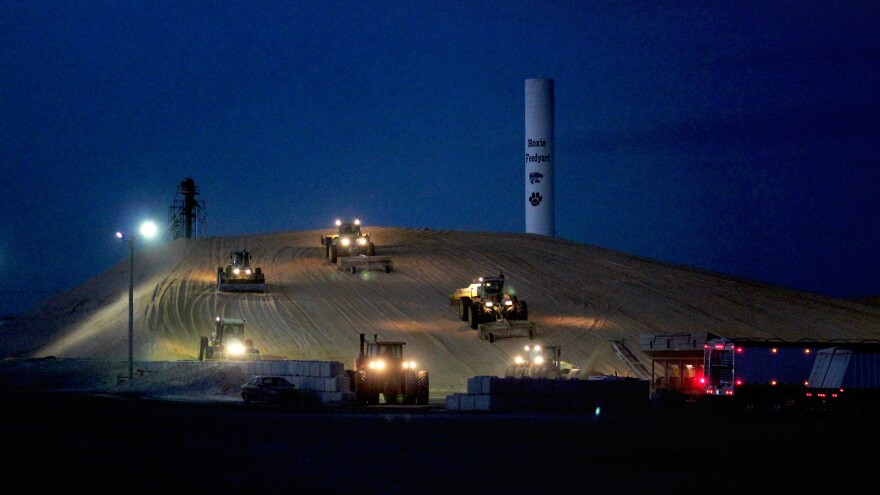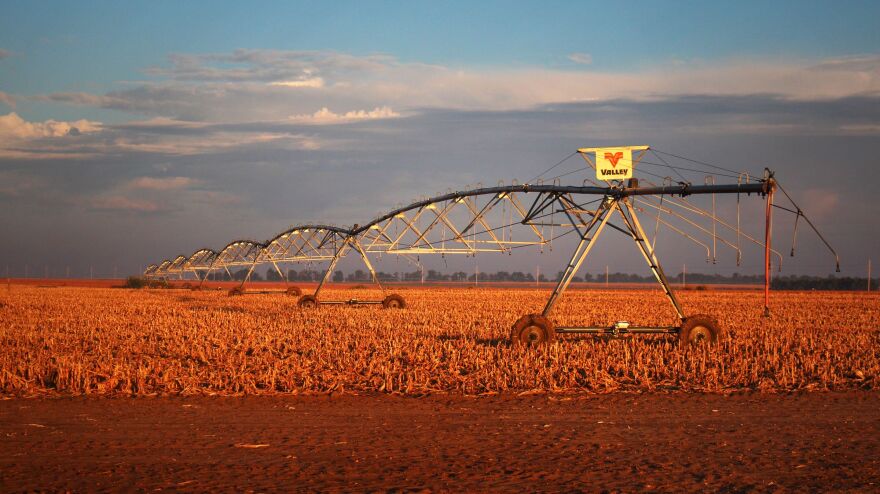If you've flown across Nebraska, Kansas or western Texas on a clear day, you've seen them: geometrically arranged circles of green and brown on the landscape, typically half a mile in diameter. They're the result of pivot irrigation, in which long pipes-on-wheels rotate slowly around a central point, spreading water across cornfields.
Yet most of those fields are doomed. The water that nourishes them eventually will run low.
That water comes from a huge pool of underground water known as the Ogallala Aquifer, part of a larger system called the High Plains Aquifer. Scientists calculate that farmers are pulling water out of the aquifer about six times faster than rain or rivers can recharge it.
That can't go on forever. In some areas, wells have already gone dry. Yet families and entire towns depend on that flow of water for their survival.
In one small section of northwestern Kansas, farmers now have agreed to do something unprecedented: For the next five years, all the farmers in this area, covering 99 square miles, will pump 20 percent less water out of the ground.
It's a remarkable agreement, but it's also fragile. Whether it survives will depend in large part on whether other farmers follow their lead.
Hoxie, the small town where farmers have taken this bold step, is the kind of place where people keep track of how many children go to the town's school. It's a barometer of the town's health.
"When I was in high school, we had 36 to 42 in every class," says farmer Mitchell Baalman. "Now, these classes are down to 15. Ten to 15 in every class."

But things have been turning around lately, Baalman says. There are more kids in the younger grades. There are a few more jobs in Hoxie, keeping families around.
Some of those jobs are on Baalman's own farm. It's a huge operation of some 12,000 acres. And as I interview him, he's driving down Highway 24 with a semi-trailer loaded with 25 tons of corn. "We're taking it to Hoxie Feedyard over here, to feed 60,000 head of cattle," Baalman shouts above the roar of the motor.
Corn and cattle are what bring money into Hoxie. And those businesses are built on water. "Rain makes grain! I mean, we are in an arid climate. We've been averaging, I think, 18 inches of rain a year," Baalman says.
That rainfall is enough to grow a modest corn crop, but not a big one. And sometimes the rains don't come at all. So the most productive fields around here have those pivot irrigation rigs.
"We always used to take it for granted that the water was just going to be here," Baalman says. Increasingly, though, farmers in this area are realizing that the days of plentiful water are numbered.
A few years ago, officials from the state of Kansas who monitor the groundwater situation came to the farmers of Hoxie and told them that the water table here was falling fast. They drew a line around an area covering 99 square miles, west of the town, and called together the farmers in that area for a series of meetings.
They told the farmers that the water was like gasoline in the tank. If every one agreed to use it more sparingly, it would last longer.
Proposals to cut back water for irrigation have not been popular in parts like these, to say the least. In the past, farmers across the American West have treated them like declarations of war. Raymond Luhman, who works for the groundwater management district that includes Hoxie, says that's understandable: "Many of them feel like the right to use that water is ..." he says, pausing, "it's their lifeblood!"

It's also their property. Under the law, it's not clear that any government can take it away from them, or order them to use less of it.
But in Hoxie, the conversation took a different turn.
Some influential farmers, including Baalman, pushed for everybody to pump less water. Baalman talked about his four children, how he wanted to preserve water for them.
He also talked about the town, and how it depended on irrigated agriculture. He argued that it would be better for the town to manage that water, to keep it flowing in the future.
"We want to keep people moving back. We want to keep our businesses going, and our downtowns, in these little towns," he says.
Last fall, the farmers of Hoxie agreed to the cutbacks in irrigation. The state government then made it a formal requirement. State officials will check the water meters on each pump to make sure it happens.
Scott Foote, who runs Hoxie Feedyard, the biggest business in town, says the key to what happened in Hoxie was the community. "It was a lot of neighbors got together, that know each other personally, go to church with each other, kids go to school with each other. Honestly, it's just a tightknit community," he says.
But the ending of this story hasn't yet been written. This agreement is just for five years. There are a lot of questions about whether it will continue beyond this trial period.
Baalman certainly wants it to. "I'm going to fight hard that we renew it," he says. "It's my name at stake. And I don't want to sound selfish, but I don't want to let my kids down. We've got a great corps of youth in Sheridan County, Thomas County, and I don't want to let them down!"
On the other hand, there are farmers who are not so sure about this water-saving idea.
Kevin Wark, in fact, is dead set against it. He's not part of the core community of Hoxie; he lives half an hour down the road. But one of his fields lies just inside the border of the "high-priority area" where pumping is now restricted.

"I resent being in this territory," he says, and there's anger in every word. "We've had 50 percent of the crops we can grow taken away from us. So how's that fair to me, when the guy across the road can just keep doing what's he's been doing?"
Wark says he considered going to court to fight the restrictions, but decided against it. Nobody in Hoxie seemed willing to join him.
Another farmer, Gary Moss, says he supports the agreement, but he's really waiting to see if farmers in other parts of western Kansas will do anything similar. The farmers of Hoxie don't want to stand alone in this, he says. It wouldn't be fair.
"If nobody else is jumping onboard, I think there's a lot of people who will say, 'We're not doing any good. We're just hurting ourselves,' " he says.
It's a paradox. This agreement to pump less water only happened because it was small: a deal among neighbors who cared about their town. But it may not survive unless it gets much bigger, including farmers all across the High Plains Aquifer.
Copyright 2021 NPR. To see more, visit https://www.npr.org.






